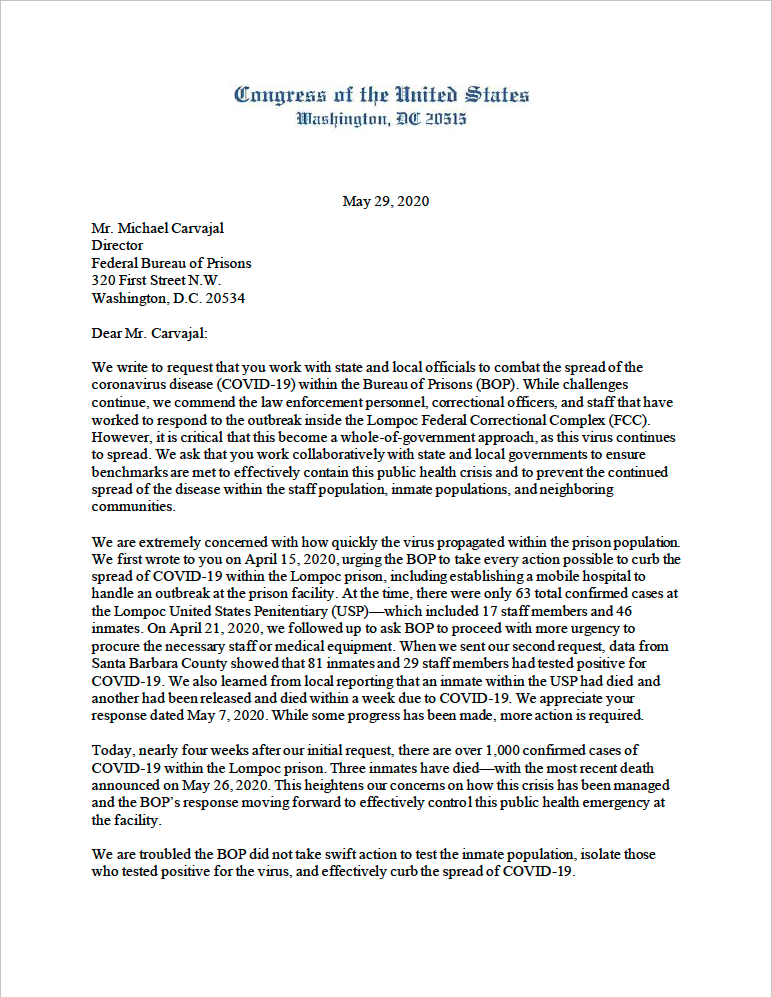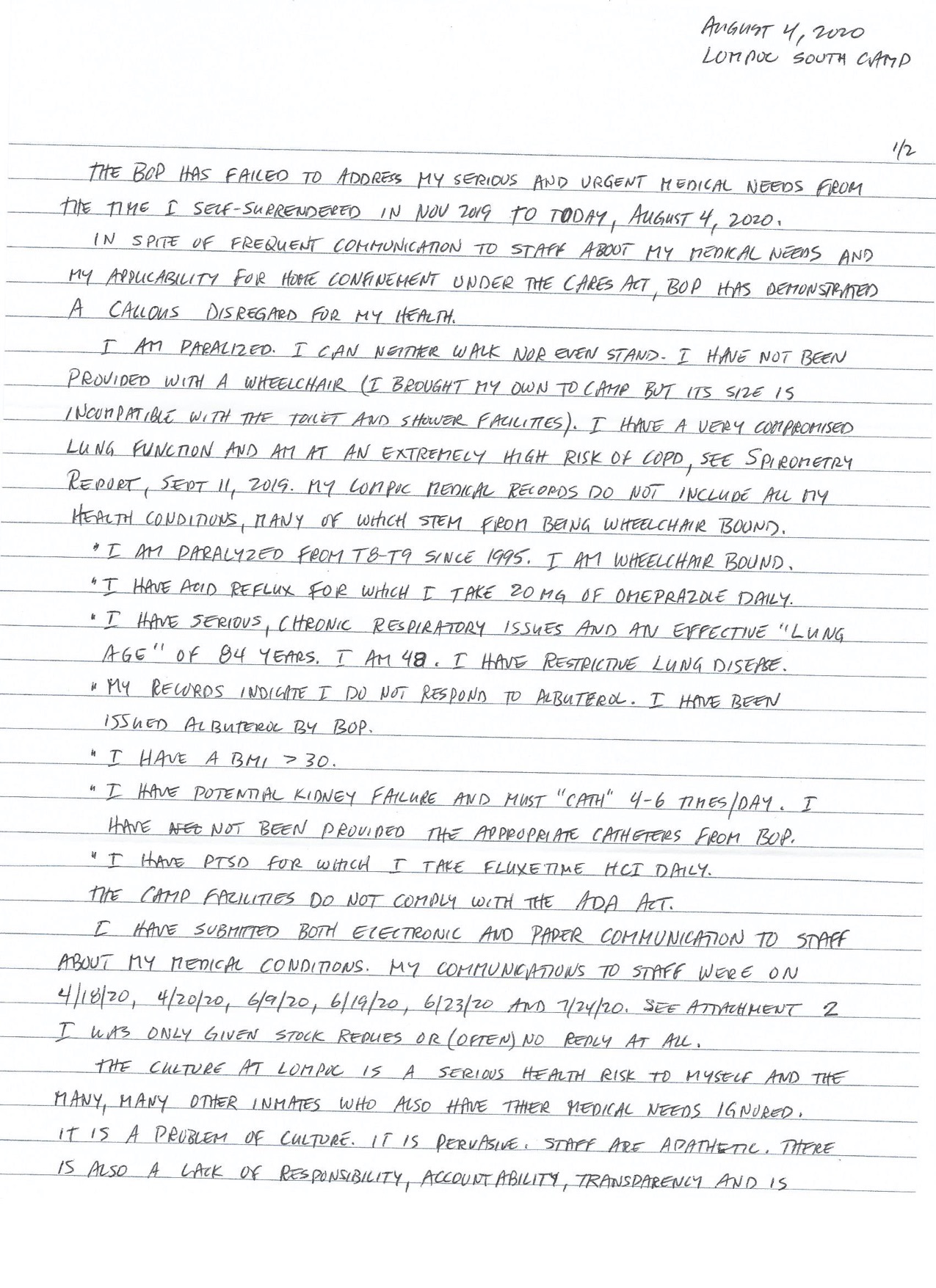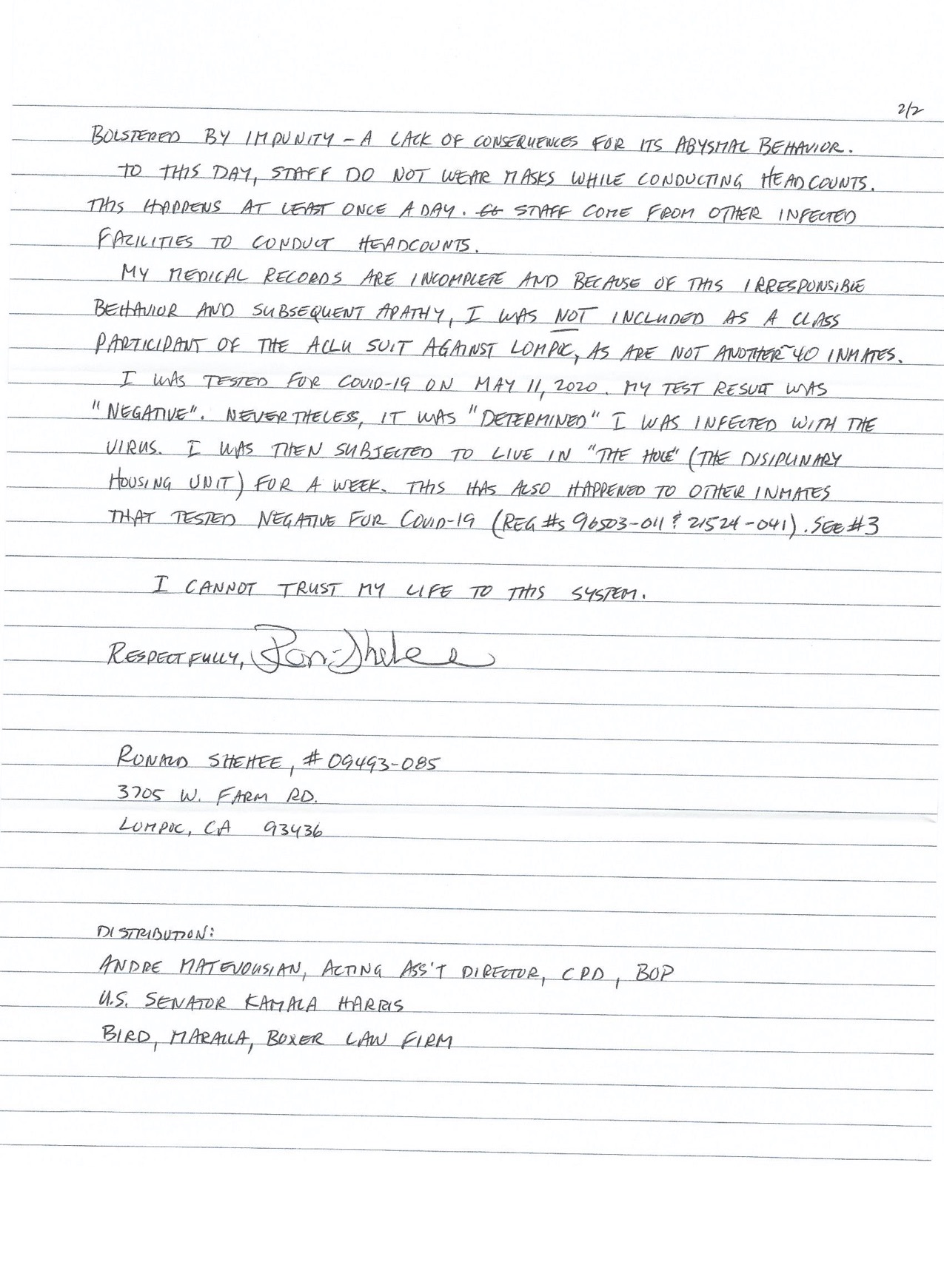Lompoc Prison
Voices from the inside
during the height of the COVID-19 Crisis
Introduction
This oral history and data justice project is part of a series by Global Environmental Justice to expose stark disparities and disproportionate impact of human and environmental rights in Santa Barbara County.
This is the most comprehensive documentation of severe human rights violations during the height of COVID-19 at Lompoc Prison; in addition to information regarding Lompoc Prison’s little known status as a Superfund Site.
This website was developed for the public to understand the depth of the humanitarian and environmental crisis that takes place just miles away from one of the wealthiest communities in California, and to provide extensive information for researchers, human rights and environmental activists to pursue investigations.
Ron Shelee
Ron Shelee was incarcerated at Lompoc prison’s minimum security camp for 11 months, from November 2019 to September 2020, during the height of the COVID crisis.
The Federal Correctional Institute in Lompoc, CA is located in Santa Barbara County. It includes a men’s medium-security penitentiary with an adjacent minimum-security prison camp. According to the Bureau of Prisons (BOP), the average offender at the Camp is imprisoned for a nonviolent drug-related offense. 51% of the incarcerated men are Latino. 13% of the incarcerated men are Black, a statistic that is double the state’s Black population which stands at 6.5%.
Ron is paralyzed from the waist down and has used a wheelchair for the past 26 years.
Ron's health conditions include problems with his kidneys and bladder, COPD and Acid Reflux. He has severe breathing problems. Ron is 49, but his doctors told him he has the lung capacity of an 84-year-old man. He gets severe headaches if he is unable to use his catheter regularly.
While incarcerated at Lompoc, Ron was denied vital medications, catheters – and at times, even his wheelchair.
Ron: “...Overall, the treatment at Lompoc, I think is very, very poor for anybody of any medical needs...”
He was sentenced for 5 years at the minimum security camp. After a long struggle to secure his release when COVID was raging through the prison and it was estimated that nearly all incarcerated men had contracted COVID, Ron finally secured compassionate release.
At the height of the pandemic when Lompoc prison had the highest rate of COVID amongst all the BOP facilities, Ron said there was no social distancing, there were no masks. Instead, prisoners were jammed into overcrowded spaces, including a moldy lunch room turned makeshift medical ward.
In addition to the human rights violations experienced by Ron, his story also draws attention to the environmental rights violations of Lompoc prison. The prison is situated on a landfill that may according to the Army Corp of Engineers contain unexploded weapons and according to the EPA underground petroleum tanks. In 1982 Lompoc prison was entered into the Comprehensive Environmental Response, Compensation, and Liability Information System otherwise known as Superfund, designating it as an abandoned waste site, with no record of a clean up.
Learn more about Superfund
﹀
“They said that was the only prison that was wheelchair accessible. That would take me. Other prisons, other camps I should say, would not accept me because they was not wheelchair accessible, which come to find out Lompoc is not either. But it was too late. I was there.”
Ron’s daughter drove him from Washington State to surrender himself at Lompoc. Although he was assured by the judge presiding over his case that he would receive proper medical care at Lompoc, upon arrival he realized they were not at all equipped to receive someone who could not walk.
Lisa: “...in Lompoc it was me helping him saying he needs to advocate for himself...”
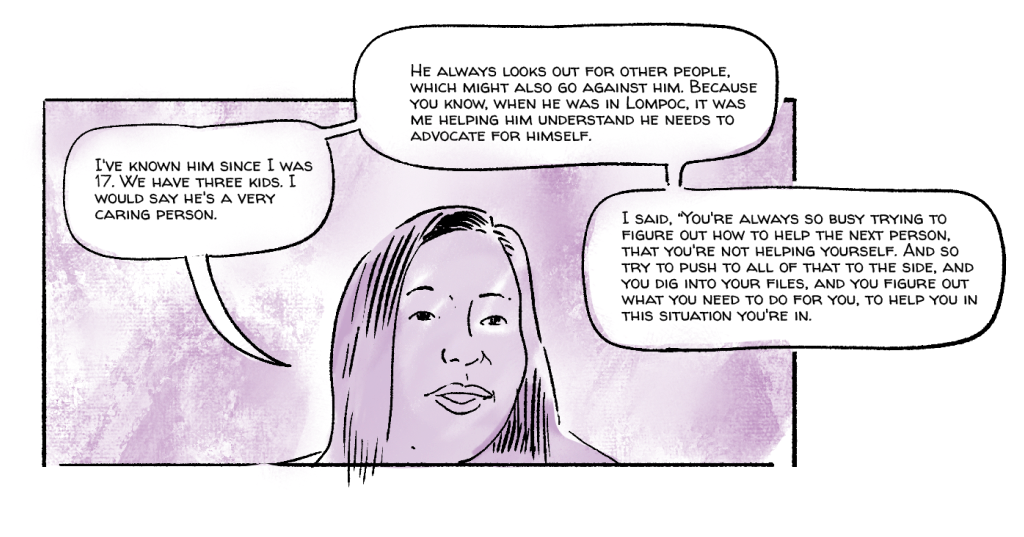
Ron described Lompoc as wheelchair inaccessible, a violation of federal law. He said the prison was never equipped to deal with Ron's disability. And, he said prison staff even told him as much when he arrived.
Lisa: “...Then they said ‘you should not have been sent here.’”
Lisa and close family members were a 17-hour car ride away from Ron at Lompoc. Because of the distance, they were never able to visit him after he initially surrendered himself.
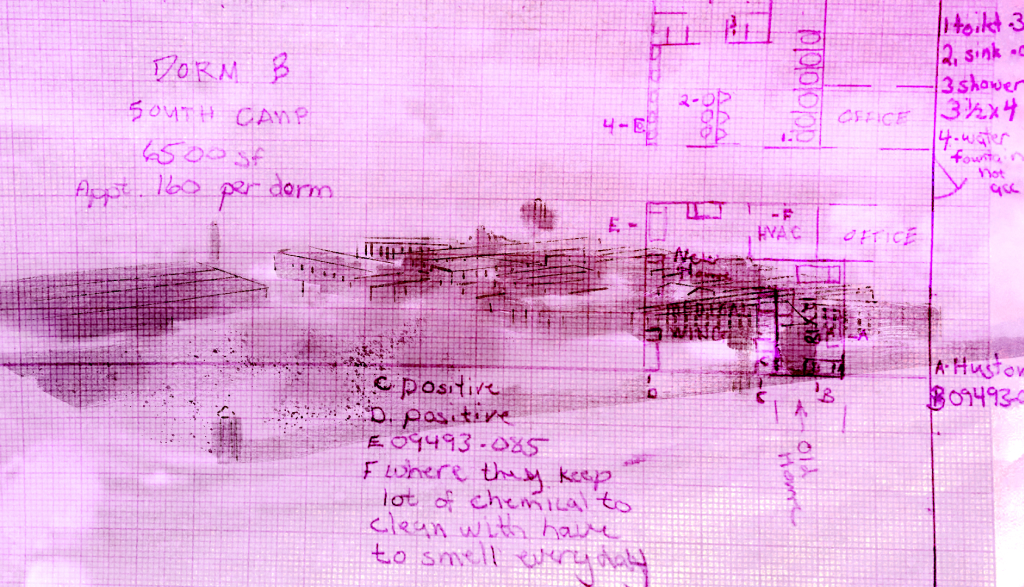
Lompoc staffers forced Ron to use a wheelchair that didn’t fit his disability when he arrived at Lompoc. Ron told them:
Ron: “I said this chair is not up to standards to where I need to be at today.”
Ron’s housing unit had one bathroom. There were three toilets to serve 250 men. The housing unit’s one bathroom posed major problems for Ron and highlights the numerous indignities he experienced due to his disability.
Ron: “ He said I don't know why they sent you here.”
Ron said that he received good care from some prison doctors. Other medical care providers, prison staff and officials got in the way of medical treatment necessary to keep his health from severely deteriorating.
One doctor tried to help Ron advocate for his medical needs. But the Doctor expressed to Ron that he could not understand why Ron was at Lompoc because it is not prepared for someone in a wheelchair. He said I don’t know why they sent you here.
Ron: “ So now I'm almost a week to two weeks in without taking a shower here...”
From the day Ron surrendered at the prison, he went three months without vital medication. Ron suffered from swollen legs and headaches in three months he languished without the catheters or medications prison administrators wouldn’t allow him to have.
Ron: “And when I got there, they took all my medications.”
When Ron finally did get his medications, he said that they weren’t the right ones. He was also denied the catheters that he needed.
Ron: “I was supposed to be cathetering myself six times a day. And now I'm forcing myself to urinate.”
Ron did not receive any catheters until near the end of his time at Lompoc.
COVID-19
COVID hit Lompoc prison hard. For several months the facility had the highest rates of COVID in the BOP system.

Ron: “ So luckily, very luckily that all these times these people that were diagnosed with this COVID using my chair to get down there, I never got infected.”
Lompoc had no way of transferring sick inmates out of the prison. According to Ron, they used his wheelchair as transportation for months. With all the extra wear and tear, his wheelchair finally broke.
Ron: “ My chair breaks. So now I'm in a bad position.”
Ron’s family was shocked that he was incarcerated given his health conditions even prior to entering Lompoc prison.
Lisa: “We were like, there's no, there's no judge that's really going to put someone who's in this medical condition behind bars.”
At one point, Ron’s doctor offered to file for a transfer out of Lompoc. But there was a catch: If he was relocated, he said he was told there was no guarantee it would be to another federal detention camp; Ron could be placed in an actual prison, in a lockup more severe than Lompoc’s minimum-security camp. So, Ron decided to stay put.
Housing during COVID
During the initial deadly outbreak of COVID at Lompoc, inmates were housed in overcrowded conditions. Ron was housed in a small room with 3 other people, in a space that used to be a storage room. One man who slept close to Ron died of COVID, Lompoc authorities still kept them in the room. Ron asked for a COVID test. This was during the time when there was growing public concern over the conditions at Lompoc.
Chrissie Rogers who’s husband was incarcerated at Lompoc during the height of COVID had previously started an advocacy group called Love Your Inmate. Love Your Inmate became a vehicle for sharing information amongst family members who were cut off from contact. She also organized several protests against the conditions.
Learn more about the protests
﹀
Lompoc and Santa Barbara leaders (Patricia Solorio, Jane Quant) mobilized with Chrissie to launch Lompoc Family Task Force to empower families and advocate for immediate change.
Chrissie Rogers: “ we've come to the conclusion that the BOP really just disregards anything that anybody tells them to do.”
Alarmed by the rapidly deteriorating situation in Lompoc, Congressman Salud Carbajal, then US Senator Kamala Harris and Senator Diane Feinstein wrote several letters to then BOP Director Michael Carvajal demanding a response to the unfolding humanitarian crisis at Lompoc prison.
The conditions during COVID continued to deteriorate.
Ron: “ And then you go outside that door there's about another 100 and some people out there sleeping in bunks.”
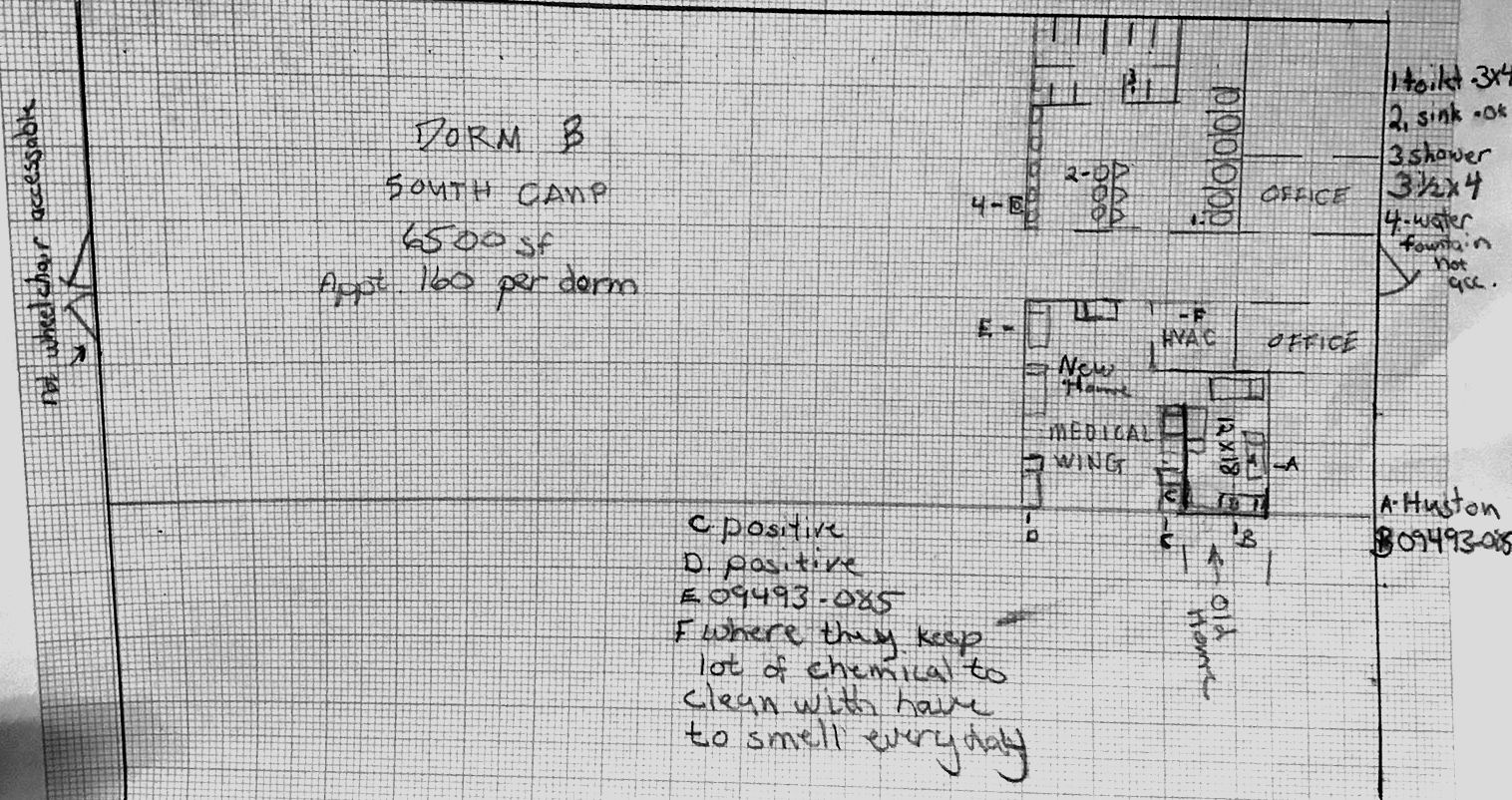
The Lompoc Administration also reopened a kitchen that had been condemned due to mold, as a housing unit.
Ron said, “They were supposed to be remodeling the kitchen because it was moldy and everything. But when COVID came, they started housing people over there in the place that they can’t have as a kitchen. I was shocked to see that”
The moldy kitchen served as a crudely improvised medical clinic.
“I said people are supposed to be leaving this place, but nobody is leaving here. I said, we don’t even got social distancing or anything in this place. We are still cram packed in this place”
At one point, Ron was confined here with three other men, at least one whom had COVID.
Ron: “One of the guys up in actually died from the COVID. And they still kept us in their room.”
The Hole
The man who died was James Houston, Ron’s close friend. Mr. Houston was 74 years old. Ron asked to be tested for COVID-19 the week he died. Ron worried he was infected because James “only lived 2 feet away from him.”
Lompoc officials regularly sent incarcerated men to solitary confinement as a form of quarantine. Ron believes he was sent to the hole as punishment for asking for a covid test
Chrissie’s husband expressed the familiar fear of dying while isolated in the SHU which was commonly used as a form of ‘quarantine’.
Chrissie Rogers: “He's like, I'd rather die in my home.”
Later that month, Ron wrote what he titled a “statement regarding B.O.P abuse” to the Bureau of Prisons detailing the ordeal.
On Monday, May 11th, I returned to the medical clinic at 9:00 AM and the PA administered the test.
At 3:00 PM, the same day, I was called back to the medical and they informed me I was being sent to the segregated housing unit (SHU), commonly referred to as the “Hole,” where they sent prisoners involved in serious violations of prison rules.
I was treated as if I committed an offense worthy of being sent to the “Hole.”
Ron was ordered to strip naked and put on a prison-issued paper suit. It was “about 3 sizes too small” and ripped in several places.
"I am naked and only have a thin blanket to cover myself with."
The CO said he would bring Ron another blanket, but he never did. In his letter, Ron describes his cell in the hole as “small,” “dank” and “very dirty.” He said that he asked for cleaning supplies to make it more sanitary but was denied.
Ron: “ This place right here is nasty...”
Ron was finally released from solitary after 7 days. When he returned to his cell, Ron injured his right side trying to transfer from his wheelchair into his cell’s shower. When he slipped and fell, Ron said he couldn’t reach the emergency button because it was placed too high for someone in a wheelchair to reach. When he couldn’t get assistance, Ron crawled back to his bunk. He was bruised so badly from the fall that extra fatty tissue developed, and he still experiences pain today.
Ron: “I bruised my body so bad that I end up gaining extra fat tissues right there. That is still painful today and my daughter and I'm trying to figure out what we're gonna do about that.”
Lompoc’s slow, lax response to COVID contributed to a deadly outbreak at the entire prison complex, including Ron’s camp. The local newspaper, the Santa Barbara Independent, reported on a federal investigation into conditions at Lompoc as the pandemic worsened.
“It took Lompoc officials more than two weeks to carry out an order from their superiors at the Bureau of Prisons (BOP) to begin the “compartmentalization” of staff because the complex didn’t have enough bodies to fill all its mandatory posts, including 24-hour guard duty at local hospitals where some Lompoc inmates were receiving care. By the end of April, the BOP had dispatched nine medical staff and 99 correctional officers from other prisons around the country to fill Lompoc’s ranks.”
Staff screenings for COVID were minimal. The men jailed at Lompoc weren’t properly monitored or tested when they showed signs of the virus. One man who had been coughing and vomiting – confirmed symptoms of COVID-19 – wasn’t admitted to the hospital for two days. The Independent reported:
“By that time, the virus was starting to take hold across multiple units in the prison, ultimately infecting more than 1,000 inmates and staff. Four inmates died from the virus, and others suffered debilitating medical complications. At one point, the complex had one of the highest infection rates in the entire federal prison system.”
Lisa: “Probably until after Houston passed away from COVID. That was really when he was like, I think he got super scared.”
Ron and Lisa both wrote numerous letters to try to save Ron’s life.
Lisa contacted Lompoc officials on Ron’s behalf.
“You know, I said, this is cruel and unusual punishment.”
Lompoc Administrators were not keeping an accurate count of testing which raised alarms for families as well as the Federal Government. In response to reports of uncontrolled infection at Lompoc prison, The Federal Department of Justice ordered its Inspector General to conduct an investigation into the conditions of the prison. The Final DOJ report, General Pandemic Response Report: Remote Inspection of Federal Correctional Complex Lompoc, released in July 2020, found that staffing shortages, inadequate screenings, a scarcity of protective equipment, poor communication, and a lack of leadership lead to the deadly outbreak at Lompoc. Additionally, the failure to follow the directives of the CARES Act which ordered the BOP to prioritize home confinement for those at serious health risk increased the death rate and rate of severe illness at Lompoc.
Chrissie Rogers: “So their numbers don't add up.”
Documentation confirms Chrissie's suspicions.
Below is a brief sample of Lompoc’s COVID testing records, obtained through a FOIA request. This sample is reflective of the total 181 page testing record. It provides evidence of a consistent pattern of isolation in solitary confinement for men despite negative tests; discrepancies such as listing those with negative tests as recovered; ongoing symptoms despite being labeled as ‘recovered; isolation occurring over a week after a negative test was reported; retests occurring almost two months after initial testing and forced isolation in solitary confinement. These records corroborate the stories from the inside, reporting regular use of the SHU for isolation despite negative Covid tests.

Notably, the DOJ Inspector General reports that the first staff member to test positive for Covid occurred on March 27th 2020. But in Lompoc’s records, there is no record of this person testing positive in the Lompoc Covid records.
Home Confinement
On April 3, 2020 Attorney General Barr issued a memorandum entitled “Increasing Use of Home Confinement as Institutions Most Affected by Covid-19” to immediately maximize appropriate transfers to home confinement. In the three following weeks, BOP Central Office sent Lompoc 9 rosters identifying 509 inmates determined potentially eligible for home confinement. Lompoc determined that approximately 150 inmates identified by the BOP Central office were eligible to be transferred to home confinement or an RRC (Residential Re-entry Center) But more than one month after the memorandum was issued, only 9 of those had been placed into home confinement or RRC under the CARES Act.
Ron: “Doing your time I do feel like it should fit your crime, that’s why we were at a camp, not behind the wall. My crime did not fit my time because of how much suffering I had to deal with.”
Pattern Scores
According to Attorney Don Spector, Executive Director of Prison Law Office, The ACLU filed motions against the BOP because the BOP and Lompoc’s Warden were not following regulations according to DOJ’s memorandum under Attorney General Barr, for releasing people on home confinement. Instead the Warden and BOP regularly used prior offenses as a disqualifier for compassionate release. Additionally, a predictive algorithm, Prisoner Assessment Tool Targeting Estimated Risk and Needs (PATTERN), was used to discourage compassionate release. PATTERN scores predict risk of recidivism. PATTERN and other predictive policing tools used by the criminal legal system have come under intense criticism for embedded bias which disproportionately punishes and targets marginalized people (O'Neil, 2016; Benjamin, 2019) PATTERN scores assess 17 variables including age of first arrest, criminal history, infractions convictions while incarcerated, education, number of programs completed. non-compliance with financial restitution. These select variables do not account for overpolicing in BIPOC neighborhoods, financial constraints post-release (Alexander, 2010), dis-investment in education, biased distribution of infractions based on discrepancy of prison guards, as well as elimination of educational programs, such as in In Lompoc, where all educational programs in the Camp had been eliminated. These factors became determinants of release that provide equal or greater weight to release decisions than health conditions, therefore forcing the most vulnerable to remain incarcerated where, “the risk of getting COVID, getting sick because of COVID and then not being treated is really high.”
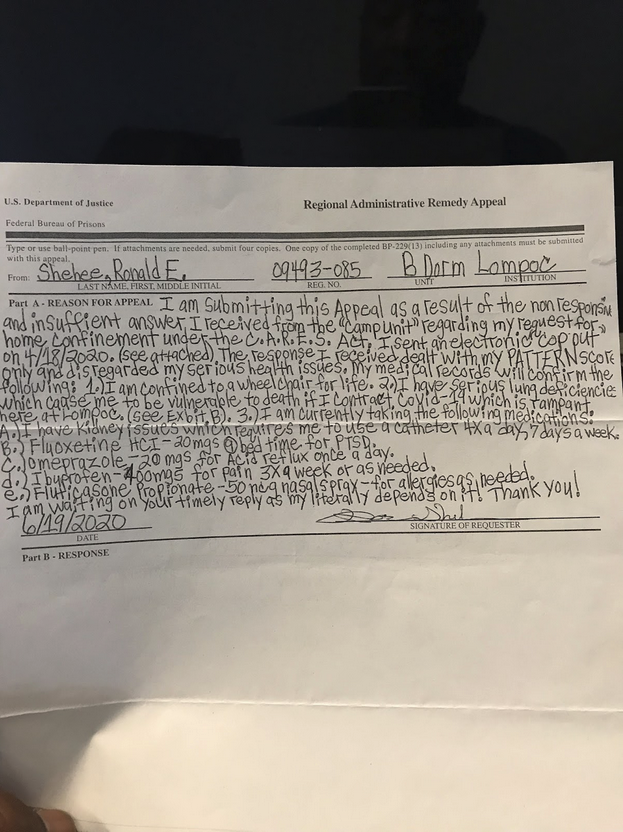
Ron: "If you are in prison you are still human…I think you should still be treated like a human. At Lompoc you don’t get that."
In May 2020 a class action lawsuit was filed on behalf of a number of men who were incarcerated during the same period of time as Ron. They charged former Lompoc Warden Louis Milusnic and former BOP Director Michael Carvajal of deliberate indifference leading to cruel and unusual punishment, a violation of the 8th Amendment. The suit was settled in November 2022. As part of the settlement Lompoc was ordered to follow the law and implement the conditions of the CARES Act.
Ron was determined to speak out about his harrowing experience at Lompoc and hopes his story will help bring change to the system that is responsible for at least 311 Covid deaths across the Federal system.
"I told myself that when I got out I would try to help people as much as I can because I knew that place was nothing but a death trap for especially the coronavirus"
Lompoc COVID Timeline
Ron Shelee enters Lompoc in November 2019
2020
January 31
BOP Health Services Division issued a memorandum to all BOP institutions informing them of possible COVID-19 symptoms
February 29
BOP directed institutions to screen staff with potential COVID-19 risk factors
March 13
BOP issues further directive instructing institutions in areas with “sustained community transmission” which included Lompoc to implement enhanced health screening of all staff. Inmate social and legal visits suspended “ in accordance with BOP guidance”
March 16
Ineffective screening of staff begins. 2 staff members experiencing COVID symptoms were not detected and were allowed to work.
March 19
Senator Harris letter to BOP
March 22
An inmate informs staff he has COVID symptoms but was not tested. He was examined four times before he was finally admitted to the Hospital
March 26
The inmate was admitted to the hospital
The Attorney General directs BOP to prioritize the use of home confinement to combat the dangers that COVID 19 posed to “at risk inmates who are non-violent and pose minimal likelihood of recidivism.”
March 27
Institution medical staff starts testing inmates for COVID-19 if they are experiencing symptoms. The innate mentioned above is tested for COVID.
1st staff member tests positive for COVID
The quarantine unit was relocated to an unused USP Lompoc housing unit (H-Unit) while the isolation unit remained in the SHU range.
Trump signs the CARES Act - authorizes BOP Director to lengthen the maximum
amount of time that an inmate may be placed in home confinement
“We believe that Lompoc should have taken greater precautions to isolate an inmate with an indeterminate illness that could have been related to COVID-19. Keeping this inmate in general population for several days increased the risk of COVID-19 transmission to institution staff and other inmates”
March 30
The inmate mentioned above is confirmed to have COVID-19
March 31
BOP supplemental guidelines - limit staff movement
Acting Complex Warden from Tucson arrives - staff finally begins to receive information and guidance
“FCC Lompoc has been led by 3 different officials serving as the acting Complex Warden since the onset of the outbreak. 9 out of 14 of Lompoc management officials interviewed were TDY (temporary) staff in acting capacity.”
The Complex Warden position became vacant on Jan. 19, 2020.
“We believe that the limitations of the BOP’s staff screening procedures in March, coupled with Lompoc staff who did not report all COVID 19 symptoms to screening staff, may have contributed to the COVID 19 outbreak across FCC Lompoc.”
April 1
Inmate movement restricted ‘stay in place’ orders
April 2
Lompoc officials relocated the isolation unity to the H-Unit to accommodate the rise in COVID-19 cases and the quarantine unit was moved to the USP’s M-Unit
From the Independent - Tyler reporting - ‘More Suffering and Death at Lompoc’:
According to Santa Barbara resident Barbara Quinn, whose son Michael is serving time on a fraud conviction, Yusuf had been intensely sick the last week and a half, “coughing and choking and not being able to breathe.” Quinn, who spoke to her son by phone on Wednesday, said other prisoners had “begged the guards for help, but no one would do anything.” Her account was corroborated by Diana Lopez, the wife of another Lompoc inmate. Her husband told her that guards accused Yusuf of “faking it.” From New York, Yusuf was serving a 132-month sentence for conspiracy to support a foreign terrorist organization.
Quinn claimed the much-touted hospital unit the prison complex erected earlier this month to treat COVID-19 patients has not been used because it remains unstaffed and not fully equipped. “It was completely for show,” she said, discounting the BOP’s announcement that included photos of the renovated space with fresh paint and new flooring. “It was a total publicity stunt.” Other inmates in contact with the Independent have made similar accusations about the hospital unit. Santa Barbara County officials admit they have no knowledge about its operations.
April 3
Memorandum by Attorney General entitled “Increasing Use of Home Confinement as Institutions Most Affected by COVID-19” to immediately maximize appropriate transfers to home confinement where COVID is affecting operations.
April 4 - May 15
BOP Central office sent FCC Lompoc 9 rosters identifying 509 inmates determined potentially eligible for home confinement.
Three or more weeks passed between the time the Central Office identified an inmate for transfer consideration to the date the inmate was transferred to home confinement.
“As a result, we found that in April FCC Lompoc’s ability to use home confinement in response to the spread of COVID-19, as a mechanism to reduce either the at-risk inmate population or the overall prison population and facilitate social distancing was extremely limited.”
March 26 - June 4
Number of inmates placed into home confinement or an RRC increased from 34 to 124. Lompoc data indicated that 38 of these inmates had been placed into home confinement while 86 of them had been placed into an RRC
COVID outbreaks in two RRCs delayed 2 Lompoc inmates from transferring them.
April 6
BOP directs the distribution of face coverings to all staff and inmates - but transmission and spread of the virus within institutions is already occurring.
April 10
Institution staff members receive cloth face coverings
April 12
Approximately 115 low and medium security Lompoc inmates had 6 months or less remaining in their sentence. Nearly all of these inmates would have eligible for immediate home confinement consideration under BOP guidance and existing law.
April 14
Inmates receive cloth face coverings
Acting Complex Warden sends a memorandum to all FCC staff to limit movement. 15 days after the BOP had directed these steps - and more than 2 weeks after Lompoc identified first COVID cases
April 15
Senators Harris, Feinstein and Congressman Carbajal write 1st of 3 letters to BOP to “move quickly in approving the request from the Lompoc USP to establish a 50-bed mobile hospital and provide the workers with the necessary equipment and tools to protect themselves from continued exposure to COVID-19.”
April 18
Ron writes a letter to Warden Von Blankensee regarding compassionate release “CDC guidelines clearly indicate I fall into a HIGH RISK group for contracting the COVID-19 virus.”
April 20
Lockdown for “health related reasons” “this escalation suspended some inmates’ access to showers and commissary
- The BOP did not direct institutions to suspend commissary privileges
- During lockdown approximately 1000 USP inmates did not have access to showers
- Inmates were prohibited from using the law library to work on their legal cases.
- During lockdown inmates were confined to cells for 24hour/day without recreation which is more restrictive than conventional Special Housing Unit (SHU) placement
- At FCI inmates are housed, open dormitory style with bunk beds three feet apart
- Inmates were provided with multiple hygiene kits that contained a razor, a toothbrush, toothpaste and soap so inmates could wash themselves at the sink in their cell
- Concerns about the quality of masks. A union official said the masks were not very effective and may not have adequately safeguarded staff and inmates from contracting the virus.
- FCC Lompoc set up cots for inmates in the FCI gym and a closed UNICOR factory
- A total of 252 beds in non-housing locations such as the chapel, the visiting room, tents and in Residential drug abuse program space, in addition to locations previously mentioned.
April 21
Senators Harris, Feinstein and Congressman Carbajal write 2nd of 3 letters to BOP
“We continue to be concerned about the growing outbreak of the coronavirus disease 2019 (COVID-19) at the Lompoc United States Penitentiary (USP)and the response from the Bureau of Prisons (BOP)to mitigate this crisis. While we are grateful the BOPis moving forward with establishing a mobile hospital as we had requested, we are writing to you today to continue stressing the need for the BOP to move with urgency in establishing this facility with the necessary staff and equipment—including ventilators. Additionally, we are following up on our previous letter from April 15, 2020 to see what progress the BOP has made to ensure the safety and well-being of the law enforcement officers, staff,and inmates at the Lompoc USP.”
May 4
BOP announces it has finalized construction of a Hospital Care Unit (HCU) inside the walls of USP Lompoc. Cases normally requiring outside hospitalization would be treated within the prison. [what are the conditions of the HCU?]
May 10
80% of inmates (100 of 115) who had 6 months or less remaining in their sentence and most likely eligible for immediate home confinement consideration under BOP guidance and existing law - remained at FCC Lompoc - more than a month after the AG memorandum
May 11
At least 77% (891 of 1162) FCI inmates had tested positive for COVID-19 and were considered active cases “subsequently Lompoc officials indicated to the OIG that the institutions would not continue testing of all inmates because the outbreak at the USP and Camps hacd subsided and universal testing was no longer warranted.“
Lompoc prison first established quarantine and isolation units on a Range in the USPs SHU to host the last transfer of incoming inmates.
Early May
53 of 416 staff members at FCC Lompoc had been tested and approximately 60% (32 of 53) tested positive
May 13
Lompoc determines that approximately 150 inmates identified by the BOP Central office were eligible to be transferred to home confinement or an RRC (Residential Re-entry Center) but by this date only 9 of those inmates had been placed into home confinement or an RRC under the CARES Act
900 inmates had contracted COVID-19 and only 8 inmates had been transferred to home confinement in accordance with the Coronavirus Aid and Relief and Economic Security Act (CARES Act and BOP Guidance)
During this time, Lompoc continued to transfer into an RRC or home confinement, inmates who were qualified to leave prison under authorities that existed prior to the CARES ACT
May 16
Class action lawsuit filed against Lompoc prison by prisoners - citing cruel and unusual punishment
May 26
Ron writes a letter describing his horrific treatment in solitary confinement and a fall from his chair.
May 29
Senators Harris, Feinstein and Congressman Carbajal write 3rd letter to BOP
June 2
Senate Judiciary Hearing Examining Best Practices for Incarceration and Detention During COVID-19
June 14
38% of inmates( 44 of 115) who had 6 months or less remaining in their sentence and most likely eligible for immediate home confinement consideration under BOP guidance and existing law - remain at FCC Lompoc
June 19
Ron writes letter confused why they would use his PATTERN score as a criteria for compassionate release when his medical conditions are life threatening
June 23
Ron writes letter to Warden Bradley regarding his request of compassionate release
July 14
US District Court Judge approved a provisional class certification for Lompoc inmates over the age of 50 with underlying health conditions. The judge's order states that “the evidence before the court demonstrates meaningful social distancing is not possible at Lompoc absent a reduction of the inmate population. There is no evidence [BOP] officials are prioritizing their use of statutory authority under the CARESAct to grant home confinement to Lompoc inmates in light of the pandemic of giving dire consideration to inmates' age or medical conditions in evaluating eligibility of home confinement. The judge ordered the BOP to among other things “make full and speedy use of the BOP’s authority under the CARES Act and evaluate each class member’s eligibility for home confinement.”
August 3
Ron receives a letter explaining he was denied compassionate release because of a low PATTERN score and serious history of violence minor history of escape
August 4
Ron writes letter to Warden Bradley to appeal his case for CARES Act compassionate release
August 5
Ron writes to the BOP describing his “serious and urgent medical needs” and decries the “callous disregard” for his health
August 10
Senators Harris, Feinstein and Congressman Carbajal letter to Congress
“We are concerned that BOP has not yet implemented universal testing or onsite testing for inmates and staff to stop the spread of the virus throughout the prison system or within our communities. We therefore urge you to work swiftly to ensure the necessary funds are made available to better equip the BOP in handling this crisis. The House of Representatives passed the HEROES Act, with $200 million for the BOP to respond to COVID-19 outbreaks,over10 weeks ago. Our communities cannot afford further delays.”
September 2020
Ron Shelee is released from Lompoc on compassionate release
